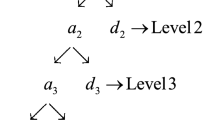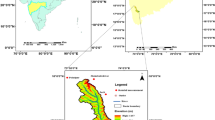Abstract
Researchers have studied to forecast the streamflow in order to develop the water usage policy. They have used not only traditional methods, but also computer aided methods. Some black-box models, like Adaptive Neuro Fuzzy Inference Systems (ANFIS), became very popular for the hydrologic engineering, because of their rapidity and less variation requirements. Wavelet Transform has become a useful tool for the analysis of the variations in time series. In this study, a hybrid model, Wavelet-Neuro Fuzzy (WNF), has been used to forecast the streamflow data of 5 Flow Observation Stations (FOS), which belong to Sakarya Basin in Turkey. In order to evaluate the accuracy performance of the model, Auto Regressive Integrated Moving Average (ARIMA) model has been used with the same data sets. The comparison has been made by Root Mean Squared Errors (RMSE) of the models. Results showed that hybrid WNF model forecasts the streamflow more accurately than ARIMA model.






Similar content being viewed by others

References
Adamowski J, Sun K (2010) Development of a coupled wavelet transform and network method for flow forecasting of non-perennial rivers in semi-arid watersheds. J Hydrol 390:85–91
Baratti R, Cannas B, Fanni A, Pintus M, Sechi GM, Toreno N (2003) River flow forecast for reservoir management through neural networks. Neurocomputing 55(3–4):421–437
Chang FJ, Chen YC (2001) A counterpropagation fuzzy-neural network modeling approach to real time stream flow prediction. J Hydrol 245:153–164
Chang LC, Chang FJ, Chiang YM (2004) A two-step-ahead recurrent neural network for stream-flow forecasting. Hydrol Process 18(1):81–92
Chen SH, Lin YH, Chang LC, Chang FJ (2006) The strategy of building a flood forecast model by neuro-fuzzy network. Hydrol Process 20:1525–1540
Dawson CW, Wilby RL (1998) An artificial neural network approach to rainfall-runoff modeling. Hydrol Sci 43(1):47–67
Dorum A, Yarar A, Sevimli MF, Onüçyildiz M (2010) Modelling the rainfall–runoff data of susurluk basin. Expert Syst Appl 37:6587–6593
Drake JT (2000) Communications phase synchronization using the adaptive network fuzzy inference system. Ph.D. Thesis, New Mexico State University, Las Cruces, New Mexico, USA
El-Shafie A, Taha MR, Noureldin A (2007) A neuro-fuzzy model for inflow forecasting of the Nile River at Aswan High Dam. Water Resour Manag 21(3):533–556
Grimes DIF, Coppola E, Verdecchia M, Visconti G (2003) A neural network approach to real-time rainfall estimation for Africa using satellite data. J Hydrometeorol 4:1119–1133
Hasebe M, Nagayama Y (2002) Reservoir operation using the neural network and fuzzy systems for dam control and operation support. Adv Eng Softw 33(5):245–260
Haykin S (1998) Neural networks—a comprehensive foundation, 2nd edn. Prentice-Hall, Upper Saddle River, pp 26–32
Jang J-SR (1993) ANFIS: adaptive-network-based fuzzy inference system. IEEE Trans Syst Man Cyberm 23(3):665–685
Jang J-SR, Sun C-T, Mizutani E (1997) Neuro-fuzzy and soft computing: a computational approach to learning and machine intelligence. Prentice-Hall, Upper Saddle River
Kisi O (2009) Neural networks and wavelet conjunction model for intermittent streamflow forecasting. J Hydrol Eng ASCE 14(8):773–782
Kisi O (2010) Wavelet regression model for short-term streamflow forecasting. J Hydrol 389:344–353
Kisi O, Shiri J (2011) Precipitation forecasting using wavelet genetic programming and wavelet-neuro-fuzzy conjunction models. Water Resour Manag 25(13):3135–3152
Kisi O, Karahan ME, Şen Z (2006) River suspended sediment modelling using a fuzzy logic approach. Hydrol Process 20:4351–4362
Lane SN (2007) Assessment of rainfall-runoff models based upon wavelet analysis. Hydrol Process 21:586–607
Luk KC, Ball JE, Sharma A (2000) A study of optimal model lag and spatial inputs to artificial neural network for rainfall forecasting. J Hydrol 227:56–65
Mallat S (1989) A theory for multiresolution signal decomposition: the wavelet representation. IEEE Trans Pattern Anal Mach Intell 11(7):674–693
Sang YF (2012) A practical guide to discrete wavelet decomposition of hydrological time series. Water Resour Manag 26(11):3345–3365
Sanikhani H, Kisi O (2012) River flow estimation and forecasting by using two different adaptive neuro-fuzzy approaches. Water Resour Manag 26(6):1715–1729
Shiri J, Kisi O (2010) Short-term and long-term streamflow forecasting using a wavelet and neuro-fuzzy conjunction model. J Hydrol 394:486–493
Smith LC, Turcotte DL, Isacks B (1998) Stream flow characterization and feature detection using a discrete wavelet transform. Hydrol Process 12:233–249
Toprak ZF, Cigizoglu HK (2008) Predicting longitudinal dispersion coefficient in natural streams by artificial intelligence methods. Hydrol Process 22:4106–4129
Wei S, Song J, Khan NI (2012) Simulating and predicting river discharge time series using a wavelet-neural network hybrid modelling approach. Hydrol Process 26:281–296
Yarar A, Onucyıldız M, Copty NK (2009) Modelling level changes in lakes using neuro-fuzzy and artificial neural networks. J Hydrol 365:329–334
Author information
Authors and Affiliations
Corresponding author
Rights and permissions
About this article
Cite this article
Yarar, A. A Hybrid Wavelet and Neuro-Fuzzy Model for Forecasting the Monthly Streamflow Data. Water Resour Manage 28, 553–565 (2014). https://doi.org/10.1007/s11269-013-0502-1
Received:
Accepted:
Published:
Issue Date:
DOI: https://doi.org/10.1007/s11269-013-0502-1



